WW2 Medical Department Medal of Honor Recipients
The Medal of Honor is the highest military decoration awarded by the United States of America. The decoration is bestowed on a member of the United States who distinguishes himself conspicuously by gallantry and intrepidity at the risk of his life above and beyond the call of duty while engaged in an action against an enemy of the United States.
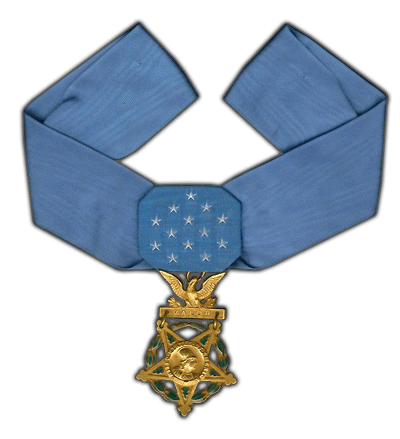
Medal of Honor, United States Army Version.
Medal of Honor, United States Army Version (above):
Gold five-pointed star, each point tipped with trefoils, 1 1/2 inches wide, surrounded by a green laurel wreath, and suspended from a gold horizontal bar inscribed ‘VALOR’, surmounted by an eagle, in the center of the star, Minerva’s head surrounded by the words, UNITED STATES OF AMERICA – on each ray of the star is a green oak leaf – on the reverse is a bar engraved: “THE CONGRESS TO” – the medal is suspended by a neck ribbon, 1 3/8 inches wide, of light blue color, with a center shield of the same color adorned with thirteen white stars, arranged in the form of three chevrons – the service ribbon of the Medal of Honor is 1 3/8 inches wide with five white stars in the form of an “M” – the current Medal is the third design (by Maj Gen George L. Gillespie) and authorized by Congress on April 23, 1904 – the current neck ribbon was adopted in 1944 – the Medal of Honor has precedence over other military decorations (both the U.S. Air Force and the U.S. Navy have their own version).
The President of the United States, in the name of Congress, awarded more than 3,400 Medals of Honor to the Nation’s bravest Soldiers, Sailors, Airmen, Marines and Coast Guard personnel, since the decoration’s creation in 1861! In order to underline the acts of bravery and heroism carried out by Combat Medics in World War 2, this article has been compiled to show the 11 medical personnel who were bestowed with the award during the Second World War.
Desmond T. Doss:
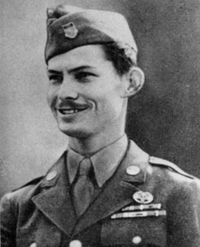 Rank & Unit: Private First Class, U.S. Army, Medical Detachment, 307th Infantry Regiment, 77th Infantry Division
Rank & Unit: Private First Class, U.S. Army, Medical Detachment, 307th Infantry Regiment, 77th Infantry Division
Place & Date: Near Urasoe Mura, Okinawa, Ryukyu Islands, 29 April-21 May 1945
He was a company aid man when the 1st Battalion, 77th Infantry Division assaulted a jagged escarpment 400 feet high. As the troops gained the summit, a heavy concentration of artillery, mortar and machine gun fire crashed into them, inflicting approximately 75 casualties and driving the others back. Pfc. Doss refused to seek cover and remained in the fire-swept area with the many stricken, carrying them 1 by 1 to the edge of the escarpment and there lowering them on a rope-supported litter down the face of a cliff to friendly hands. On 2 May, he exposed himself to heavy rifle and mortar fire in rescuing a wounded man 200 yards forward of the lines on the same escarpment; and 2 days later he treated 4 men who had been cut down while assaulting a strongly defended cave, advancing through a shower of grenades to within 8 yards of enemy forces in a cave’s mouth, where he dressed his comrades’ wounds before making 4 separate trips under fire to evacuate them to safety.
On 5 May, he unhesitatingly braved enemy shelling and small arms fire to assist an artillery officer. He applied bandages, moved his patient to a spot that offered protection from small arms fire and, while artillery and mortar shells fell close by, painstakingly administered plasma. Later that day, when an American was severely wounded by fire from a cave, Pfc. Doss crawled to him where he had fallen 25 feet from the enemy position, rendered aid, and carried him 100 yards to safety while continually exposed to enemy fire.
On 21 May, in a night attack on high ground near Shuri, he remained in exposed territory while the rest of his company took cover, fearlessly risking the chance that he would be mistaken for an infiltrating Japanese and giving aid to the injured until he was himself seriously wounded in the legs by the explosion of a grenade. Rather than call another aid man from cover, he cared for his own injuries and waited 5 hours before litter bearers reached him and started carrying him to cover. The trio was caught in an enemy tank attack and Pfc. Doss, seeing a more critically wounded man nearby, crawled off the litter; and directed the bearers to give their first attention to the other man. Awaiting the litter bearers’ return, he was again struck, this time suffering a compound fracture of 1 arm. With magnificent fortitude he bound a rifle stock to his shattered arm as a splint and then crawled 300 yards over rough terrain to the aid station. Through his outstanding bravery and unflinching determination in the face of desperately dangerous conditions Pfc. Doss saved the lives of many soldiers.
His name became a symbol throughout the 77th Infantry Division for outstanding gallantry far above and beyond the call of duty.
Harold A. Garman:
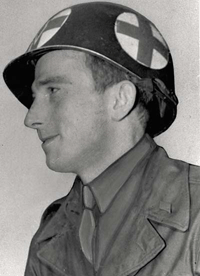 Rank & Unit: Private, U.S. Army, Company B, 5th Medical Battalion, 5th Infantry Division
Rank & Unit: Private, U.S. Army, Company B, 5th Medical Battalion, 5th Infantry Division
Place & Date: Near Montereau, France, 25 August 1944
Private Garman was awarded the Medal of Honor for conspicuous gallantry and intrepidity at the risk of his life above and beyond the call of duty. On 25 August 1944, in the vicinity of Montereau, France, the enemy was sharply contesting any enlargement of the bridgehead which American forces had established on the northern bank of the Seine River in this sector. Casualties were being evacuated to the southern shore in assault boats paddled by litter bearers from a medical battalion. Pvt. Garman, also a litter bearer in this battalion, was working on the friendly shore carrying the wounded from the boats to waiting ambulances.
As 1 boatload of wounded reached midstream, a German machine gun suddenly opened fire upon it from a commanding position on the northern bank 100 yards away. All of the men in the boat immediately took to the water except 1 man who was so badly wounded he could not rise from his litter. Two other patients who were unable to swim because of their wounds clung to the sides of the boat. Seeing the extreme danger of these patients, Pvt. Garman without a moment’s hesitation plunged into the Seine.
Swimming directly into a hail of machine gun bullets, he rapidly reached the assault boat and then while still under accurately aimed fire towed the boat with great effort to the southern shore. This soldier’s moving heroism not only saved the lives of the three patients but so inspired his comrades that additional assault boats were immediately procured and the evacuation of the wounded resumed.
Lloyd C. Hawks:
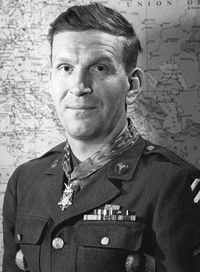 Rank & Unit: Private First Class, U.S. Army, Medical Detachment, 30th Infantry Regiment, 3d Infantry Division
Rank & Unit: Private First Class, U.S. Army, Medical Detachment, 30th Infantry Regiment, 3d Infantry Division
Place & Date: Near Carano, Italy, 30 January 1944
On 30 January 1944, at 3 p.m., near Carano, Italy, Pfc. Hawks braved an enemy counterattack in order to rescue 2 wounded men who, unable to move, were lying in an exposed position within 30 yards of the enemy. Two riflemen, attempting the rescue, had been forced to return to their fighting holes by extremely severe enemy machine gun fire, after crawling only 10 yards toward the casualties. An aid man, whom the enemy could plainly identify as such, had been critically wounded in a similar attempt. Pfc. Hawks, nevertheless, crawled 50 yards through a veritable hail of machine gun bullets and flying mortar fragments to a small ditch, administered first aid to his fellow aid man who had sought cover therein, and continued toward the 2 wounded men 50 yards distant. An enemy machine gun bullet penetrated his helmet, knocking it from his head, momentarily stunning him. Thirteen bullets passed through his helmet as it lay on the ground within 6 inches of his body.
Pfc. Hawks, crawled to the casualties, administered first aid to the more seriously wounded man and dragged him to a covered position 25 yards distant. Despite continuous automatic fire from positions only 30 yards away and shells which exploded within 25 yards, Pfc. Hawks returned to the second man and administered first aid to him. As he raised himself to obtain bandages from his medical kit his right hip was shattered by a burst of machine gun fire and a second burst splintered his left forearm.
Displaying dogged determination and extreme self-control, Pfc. Hawks, despite severe pain and his dangling left arm, completed the task of bandaging the remaining casualty and with superhuman effort dragged him to the same depression to which he had brought the first man. Finding insufficient cover for 3 men at this point, Pfc. Hawks crawled 75 yards in an effort to regain his company, reaching the ditch in which his fellow aid man was lying.
Thomas J. Kelly:
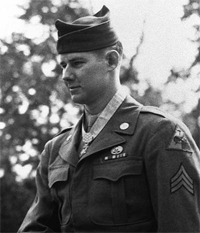 Rank & Unit: Corporal, U.S. Army, Medical Detachment, 48th Armored Infantry Battalion, 7th Armored Division
Rank & Unit: Corporal, U.S. Army, Medical Detachment, 48th Armored Infantry Battalion, 7th Armored Division
Place & Date: Alemert, Germany, 5 April 1945
He was an aidman with the 1st Platoon, Co C during an attack on the town of Alemert, Germany. The platoon, committed in a flanking maneuver had advanced down a small open valley, overlooked by wooded slopes hiding enemy machine guns and tanks, when the attack was stopped by murderous fire that inflicted heavy casualties in the American ranks. Ordered to withdraw, Cpl. Kelly reached safety with the uninjured remnants of the unit, but, on realizing the extent of casualties suffered by the platoon, he voluntarily retraced his steps and began evacuating his comrades under direct machine gun fire.He was forced to crawl, dragging the injured behind him for most of the 300 yards separating the exposed area from a place of comparative safety.
Two other volunteers who attempted to negotiate the hazardous route with him were mortally wounded, but he kept on with his herculean task after dressing their wounds and carrying them to friendly hands. In all, he made 10 separate trips through the brutal fire, each time bringing out a man from this death trap. 7 more casualties who were able to crawl by themselves he guided and encouraged in escaping from the hail of fire.
After he had completed his heroic, self-imposed task and was near collapse from fatigue, he refused to leave his platoon until the attack had been resumed and the objective taken. Cpl. Kelly’s gallantry and intrepidity in the face of seemingly certain death saved the lives of many of his fellow soldiers and was an example of bravery under fire.
William D. McGee:
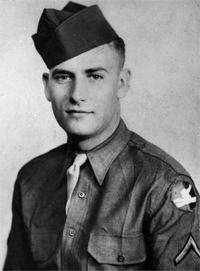 Rank & Unit: Private, U.S. Army, Medical Detachment, 304th Infantry Regiment, 76th Infantry Division
Rank & Unit: Private, U.S. Army, Medical Detachment, 304th Infantry Regiment, 76th Infantry Division
Place & Date: Near Mulheim, Germany, 18 March 1945 – Posthumous
A medical aid man, he made a night crossing of the Moselle River with troops endeavoring to capture the town of Mulheim. The enemy had retreated in the sector where the assault boats landed, but had left the shore heavily strewn with antipersonnel mines. Two men of the first wave attempting to work their way forward detonated mines which wounded them seriously, leaving them bleeding and in great pain beyond the reach of their comrades. Entirely on his own initiative, Pvt. McGee entered the minefield, brought out 1 of the injured to comparative safety, and had returned to rescue the second victim when he stepped on a mine and was severely wounded in the resulting explosion.
Although suffering intensely and bleeding profusely, he shouted orders that none of his comrades was to risk his life by entering the death-sown field to render first aid that might have saved his life. In making the supreme sacrifice, Pvt. McGee demonstrated a concern for the well-being of his fellow soldiers that transcended all considerations for his own safety and a gallantry in keeping with the highest traditions of the military service.
Frederick C. Murphy:
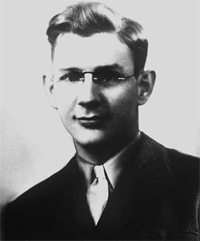 Rank & Unit: Private, U.S. Army, Medical Detachment, 304th Infantry Regiment, 76th Infantry Division
Rank & Unit: Private, U.S. Army, Medical Detachment, 304th Infantry Regiment, 76th Infantry Division
Place & Date: Siegfried Line at Saarlautern, Germany, 18 March 1945 – Posthumous
An aid man, he was wounded in the right shoulder soon after his comrades had jumped off in a dawn attack 18 March 1945, against the Siegfried Line at Saarlautern, Germany. He refused to withdraw for treatment and continued forward, administering first aid under heavy machine gun, mortar, and artillery fire. When the company ran into a thickly sown antipersonnel minefield and began to suffer more and more casualties, he continued to disregard his own wound and unhesitatingly braved the danger of exploding mines, moving about through heavy fire and helping the injured until he stepped on a mine which severed one of his feet. In spite of his grievous wounds, he struggled on with his work, refusing to be evacuated and crawling from man to man administering to them while in great pain and bleeding profusely.
He was killed by the blast of another mine which he had dragged himself across in an effort to reach still another casualty. With indomitable courage, and unquenchable spirit of self-sacrifice and supreme devotion to duty which made it possible for him to continue performing his tasks while barely able to move, Pfc. Murphy saved many of his fellow soldiers at the cost of his own life.
James K. Okubo:
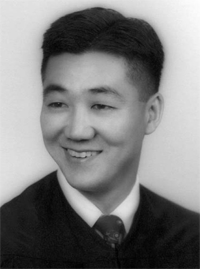 Rank & Unit: Technician Fifth Grade, U.S. Army, Medical Detachment, 442d Regimental Combat Team
Rank & Unit: Technician Fifth Grade, U.S. Army, Medical Detachment, 442d Regimental Combat Team
Place & Date: Forêt Domaniale de Champ, near Biffontaine, eastern France, 28 and 29 October and 4 November 1944
Technician Fifth Grade James K. Okubo distinguished himself by extraordinary heroism in action on 28 and 29 October and 4 November 1944, in the Forêt Domaniale de Champ, near Biffontaine, eastern France.
On 28 October, under strong enemy fire coming from behind mine fields and roadblocks, Technician Fifth Grade Okubo, a medic, crawled 150 yards to within 40 yards of the enemy lines. Two grenades were thrown at him while he left his last covered position to carry back wounded comrades. Under constant barrages of enemy small arms and machine gun fire, he treated 17 men on 28 October and 8 more men on 29 October.
On 4 November, Technician Fifth Grade Okubo ran 75 yards under grazing machine gun fire and, while exposed to hostile fire directed at him, evacuated and treated a seriously wounded crewman from a burning tank, who otherwise would have died.
Technician Fifth Grade James K. Okubo’s extraordinary heroism and devotion to duty were in keeping with the highest traditions of military service and reflect great credit on him, his unit, and the United States Army.
Laverne Parrish:
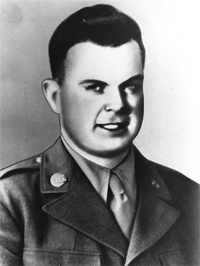 Rank & Unit: Technician 4th Grade, U.S. Army, Medical Detachment, 161st Infantry Regiment, 25th Infantry Division
Rank & Unit: Technician 4th Grade, U.S. Army, Medical Detachment, 161st Infantry Regiment, 25th Infantry Division
Place & Date: Binalonan, Luzon, Philippine Islands, 18-24 January 1945 – Posthumous
He was a medical aid man with Company C during the fighting in Binalonan, Luzon, Philippine Islands.
On the 18th, he observed 2 wounded men under enemy fire and immediately went to their rescue. After moving 1 to cover, he crossed 25 yards of open ground to administer aid to the second. In the early hours of the 24th, his company, crossing an open field near San Manuel, encountered intense enemy fire and was ordered to withdraw to the cover of a ditch. While treating the casualties, Technician 4th Grade Parrish observed 2 wounded still in the field. Without hesitation he left the ditch, crawled forward under enemy fire, and in 2 successive trips brought both men to safety. He next administered aid to 12 casualties in the same field, crossing and re-crossing the open area raked by hostile fire. Making successive trips, he then brought 3 wounded in to cover.
After treating nearly all of the 37 casualties suffered by his company, he was mortally wounded by mortar fire, and shortly after was killed. The indomitable spirit, intrepidity, and gallantry of Technician 4th Grade Parrish saved many lives at the cost of his own.
Frank J. Petrarca:
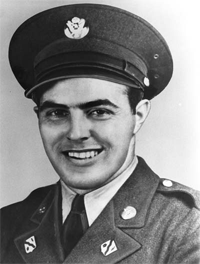 Rank & Unit: Private First Class, U.S. Army, Medical Detachment, 145th Infantry Regiment, 37th Infantry Division
Rank & Unit: Private First Class, U.S. Army, Medical Detachment, 145th Infantry Regiment, 37th Infantry Division
Place & Date: Horseshoe Hill, New Georgia, Solomon Islands, 27 July 1943 – Posthumous
Pfc. Petrarca advanced with the leading troop element to within 100 yards of the enemy fortifications where mortar and small-arms fire caused a number of casualties. Singling out the most seriously wounded, he worked his way to the aid of Pfc. Scott, lying within 75 yards of the enemy, whose wounds were so serious that he could not even be moved out of the direct line of fire. Pfc Petrarca fearlessly administered first aid to Pfc. Scott and 2 other soldiers and shielded the former until his death.
On 29 July 1943, Pfc. Petrarca. during an intense mortar barrage,went to the aid of his sergeant who had been partly buried in a foxhole under the debris of a shell explosion, dug him out, restored him to consciousness and caused his evacuation.
On 31 July 1943 and against the warning of a fellow soldier, he went to the aid of a mortar fragment casualty where his path over the crest of a hill exposed him to enemy observation from only 20 yards distance. A target for intense knee mortar and automatic fire, he resolutely worked his way to within 2 yards of his objective where he was mortally wounded by hostile mortar fire.
Even on the threshold of death he continued to display valor and contempt for the foe, raising himself to his knees, this intrepid soldier shouted defiance at the enemy, made a last attempt to reach his wounded comrade and fell in glorious death.
Ben L. Salomon:
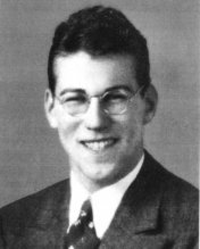 Rank & Unit: Captain, U.S. Army, Medical Detachment, 105th Infantry Regiment, 27th Infantry Division
Rank & Unit: Captain, U.S. Army, Medical Detachment, 105th Infantry Regiment, 27th Infantry Division
Place & Date: Saipan, Mariana Islands, 7 July 1944
The 105th Infantry Regiment’s 1st and 2d Battalions were attacked by an overwhelming force estimated between 3,000 and 5,000 Japanese soldiers. It was one of the largest attacks attempted in the Pacific Theater during World War II. Although both units fought furiously, the enemy soon penetrated the Battalions’ combined perimeter and inflicted overwhelming casualties.
In the first minutes of the attack, approximately 30 wounded soldiers walked, crawled, or were carried into Captain Salomon’s aid station, and the small tent soon filled with wounded men. As the perimeter began to be overrun, it became increasingly difficult for Captain Salomon to work on the wounded. He then saw a Japanese soldier bayoneting one of the wounded soldiers lying near the tent.
Firing from a squatting position, Captain Salomon quickly killed the enemy soldier. Then, as he turned his attention back to the wounded, two more Japanese soldiers appeared in the front entrance of the tent. As these enemy soldiers were killed, four more crawled under the tent walls. Rushing them, Captain Salomon kicked the knife out of the hand of one, shot another, and bayoneted a third. Captain Salomon butted the fourth enemy soldier in the stomach and a wounded comrade then shot and killed the enemy soldier. Realizing the gravity of the situation, Captain Salomon ordered the wounded to make their way as best they could back to the regimental aid station, while he attempted to hold off the enemy until they were clear.
Captain Salomon then grabbed a rifle from one of the wounded and rushed out of the tent. After four men were killed while manning a machine gun, Captain Salomon took control of it. When his body was later found, 98 dead enemy soldiers were piled in front of his position.
Captain Salomon’s extraordinary heroism and devotion to duty were in keeping with the highest traditions of military service and reflect great credit upon himself, his unit, and the United States Army.
Alfred L. Wilson:
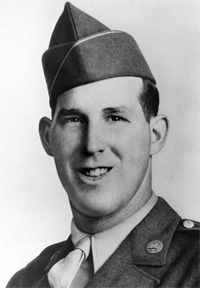 Rank & Unit: Technician Fifth Grade, U.S. Army, Medical Detachment, 328th Infantry Regiment, 26th Infantry Division
Rank & Unit: Technician Fifth Grade, U.S. Army, Medical Detachment, 328th Infantry Regiment, 26th Infantry Division
Place & Date: Near Bezange-la-Petite, France, 8 November 1944 – Posthumous
Technician 5th Grade Alfred Wilson volunteered to assist as an aid man a company other than his own, which was suffering casualties from constant artillery fire. He administered to the wounded and returned to his own company when a shellburst injured a number of its men.
While treating his comrades he was seriously wounded, but refused to be evacuated by litter bearers sent to relieve him. In spite of great pain and loss of blood, he continued to administer first aid until he was too weak to stand. Crawling from 1 patient to another, he continued his work until excessive loss of blood prevented him from moving. He then verbally directed unskilled enlisted men in continuing the first aid for the wounded. Still refusing assistance himself, he remained to instruct others in dressing the wounds of his comrades until he was unable to speak above a whisper and finally lapsed into unconsciousness. The effects of his injury later caused his death.
By steadfastly remaining at the scene without regard for his own safety, Cpl. Wilson through distinguished devotion to duty and personal sacrifice helped to save the lives of at least 10 wounded men.
All images used on this page were used with the kind permission from The Office of Medical History, U.S. Army.
